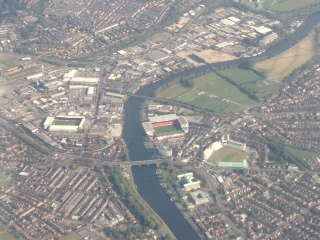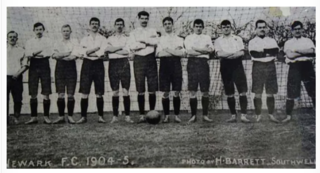
Notts County Football Club is a professional association football club based in Nottingham, England. The team compete in EFL League Two, the fourth level of the English football league system.

Trent Bridge Cricket Ground is a cricket ground mostly used for Test, One-Day International and county cricket located in West Bridgford, Nottinghamshire, England, just across the River Trent from the city of Nottingham. Trent Bridge is also the headquarters of Nottinghamshire County Cricket Club. As well as international cricket and Nottinghamshire's home games, the ground has hosted the Finals Day of the Twenty20 Cup twice and will host the final of the One-Day Cup between 2020 and 2024.

Meadow Lane is a football stadium in Nottingham, England. It is the home ground of Notts County, who have played there since it opened in 1910. The stadium was also home to Notts County Ladies F.C. from 2014 to 2017.

The City Ground is a football stadium in West Bridgford, Nottinghamshire, England, on the banks of the River Trent. It has been home to Nottingham Forest since 1898 and has a capacity of 30,455.

William Gunn was an English sportsman who played internationally in both cricket and football. In first-class cricket, Gunn played professionally for Nottinghamshire from 1880 to 1904 and represented England in 11 Test matches. In football, he played for both Notts County and Nottingham Forest as an amateur and played twice for England, scoring one goal in the inaugural 1884 British Home Championship.
The following are events in the 1860s decade which are relevant to the development of association football. Included are events in closely related codes, such as the Sheffield Rules. All events happened in English football unless specified otherwise.
Henry Alfred Cursham was an English footballer and cricketer. He played football mostly for Notts County, with spells at Corinthian, Grantham Town and Thursday Wanderers. In cricket, he played two first class games for Nottinghamshire.
Harry Butler Daft was an English footballer who played for Notts County, with whom he won the FA Cup in 1894, as well as making five appearances as a left winger for the national side. He was also an accomplished first-class cricketer, playing 200 matches for Nottinghamshire between 1885 and 1899.
The 1892–93 Football League season, was the fifth season of Football League. This season saw the introduction of the Second Division.

Nottingham is home to several high-profile sports clubs. These include two notable Football League clubs in the shape of Nottingham Forest which, along with Liverpool, is one of only two clubs in England to have won consecutive European Cups and Notts County which is the oldest professional football club in the world. Nottinghamshire County Cricket Club is a top level county cricket club, whilst both the National Ice Centre and the National Watersports Centre are also located in the city.
Notts Rangers Football Club was an English football club, founded in 1868 under the name Nottingham St James. They became Nottingham Rangers in 1880 and by 1886 were habitually referred to as Notts Rangers.
Thomas Widdowson was an English footballer who played in The Football League for Notts County.
The Town Ground was a football ground in Nottingham in England. It was the home ground of Nottingham Forest, and the first ground to host a football match using crossbars and goal nets.
The Chuckery was a cricket and football ground in the Chuckery area of Walsall, England. It was the home ground of the Walsall Swifts and Walsall Town football clubs until they merged in 1888, after which it was used by the new Walsall Town Swifts club.
John O'Gaunts was a football ground in Lincoln in England. It was the home ground of Lincoln City from 1884 until 1895.

Newark F.C. was a football club from the town of Newark-on-Trent, Nottinghamshire. It was one of the first clubs to play association football.
Notts Olympic Football Club was an English football club from the Radford district of Nottingham.
Nottingham Wanderers F.C. was an English association football club from Nottinghamshire.
Mellors Limited Football Club, also variously given as Mellors' or Mellor's Limited, was an English football club from Nottingham.
Jardines F.C. was an English association football club from Nottingham, England.







